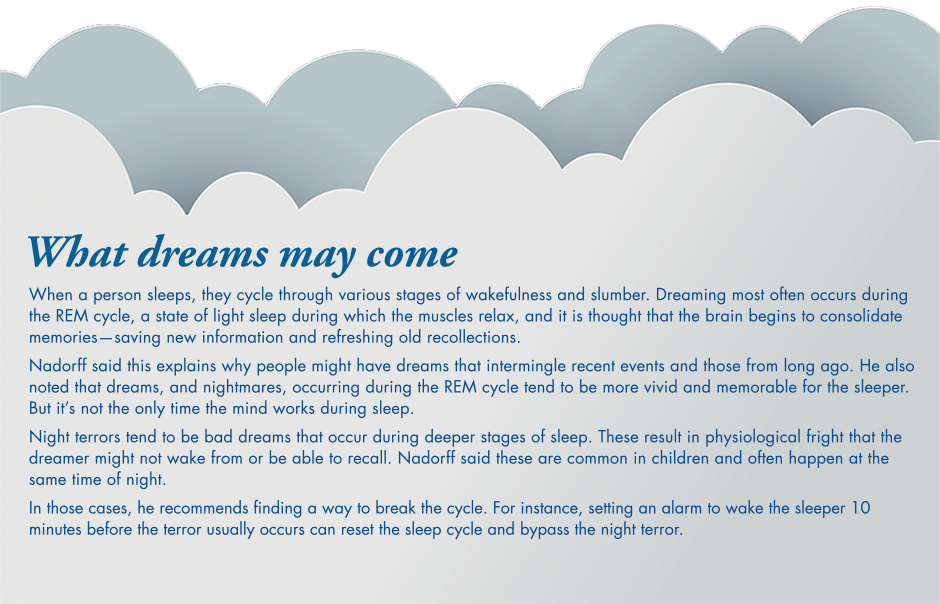
She sits in a forest. She’s on a blanket of moss surrounded by towering redwoods. A deep breath brings with it a damp, earthy smell.
She’s in Oregon. Maybe Washington. Wherever she is, it’s enchanting. The air’s crisp, but not cold; dewy, but not humid.
She hears birds in the trees and sees their shadows on the ground as they take flight. In the fallen leaves, a fox scurries by. Maybe it was a rabbit. Maybe it will come out to greet her. And maybe, if she focuses hard enough, it will chase away the blood and gore.
Maybe.
Nightmares—violent, detailed and horrifying—have plagued Tora Norheim since she was a child. The visualization described above is new. It’s the product of her work with Michael Nadorff, an associate professor of psychology at Mississippi State University. Together they are working to help her, finally, rest easy.
“There are times, if something physically happens to me in the dream, I wake up and still feel it. Like with any kind of blood, I’ll still feel the warmth. It’s very disturbing,” Norheim explained. “More often than the continued physical sensations, I’ll actually continue to see the nightmare.
“Sometimes I’ll wake up two or three times a night from nightmares,” she continued, “but I had always kind of put them on the back burner because I didn’t think it could change.”
Norheim, a senior transfer from the University of North Alabama, said she was referred to the MSU Psychology Clinic’s sleep disorder unit by the Student Counseling Center after seeking help to cope with the death of her dog.
“My dog was a constant positive reinforcement on my life, so when I lost him it really messed me up,” Norheim said. “I knew I needed help because the anxiety I already had skyrocketed. After hearing about my sleep issues, counseling services referred me to Dr. Nadorff and the sleep clinic.
“It was nice to talk to someone specifically about my nightmares,” she continued. “He’s a very sympathetic person and it was nice to hear him say, ‘It’s a good thing you’re trying to get help. No one should have to live with this.’”
Nadorff, who is director of the Sleep, Suicide and Aging Laboratory at Mississippi State, is one of the few behavioral sleep medicine specialists in a three-state radius. Through the MSU Psychology Clinic, he helps clients understand their sleep issues and teaches techniques to overcome them.
“Removing someone’s anxiety over the night makes a big difference in their days,” Nadorff explained. “Just improving someone’s sleep has been found to lead to significant improvements not only in rest but also nightmares, post-traumatic stress disorder, depression and anxiety.”
Psychologists at the sleep clinic treat a wide range of bedtime obstacles including insomnia, sleep apnea and poor sleep hygiene—behaviors and environmental factors that affect the quality of rest. Nadorff’s specialty is the treatment of nightmares, which feature heavily into his research.
Nadorff said his focus on nightmares happened as an offshoot of his original work studying the link between sleep disorders and suicidal behaviors. He found a significant relationship between nightmares and suicidal thoughts, even after accounting for anxiety, depression and PTSD—conditions known to increase the occurrence of both.
“For whatever reason, there’s a direct relation between nightmares and suicide, and we’re still pretty early in understanding what that is,” Nadorff said. “We’re still studying what brings on nightmares, but I realized it doesn’t matter what causes them; we just need to treat them.”

Nadorff estimates that 20 percent of children experience nightmares at least weekly, as do 15 percent of college students and 6 percent of adults. He said for people who regularly experience nightmares, it becomes a self-perpetuating cycle—they avoid sleep to prevent the nightmare, which causes the body to fall more quickly and deeply into REM sleep, the stage at which nightmares occur.
“By trying to avoid the dream, they can actually make themselves more likely to have it,” Nadorff said. “Nightmares won’t get better without some intervention, and treatment has been shown to improve a lot of different aspects of a person’s life.”
Nadorff’s treatment program combines counseling, to address any underlying psychological issues, and processes designed to help control the dream.
Norheim said her treatment started with image rehearsal therapy—the practice of using daytime visualization exercises to help sleepers have a dream of their choosing rather than the nightmare. For this, she created the woodland scene, a place where she felt calm, happy and peaceful. Twice a day, for five minutes, she would sit quietly and imagine herself in the redwood forest.
“You have to really try to put yourself there, really imagine it,” Norheim said. “The hope is if you practice it enough, you’ll have that dream instead of the nightmare. I haven’t been able to do that yet, but it does help with my anxiety.”
After image rehearsal, Norheim said they began working on hypnosis for lucid dreaming. This treatment helps sleepers alter their nightmares while they’re happening. This could mean giving themselves special abilities, calling for help or altering elements within the dream to make them less frightening.
“We decided to give me a superpower, a force field to protect myself,” Norheim explained. “The hypnosis is almost like guided meditation—you focus on your breathing and listen to his words as he talks you through using this power. I never felt out of control, just very relaxed.”
She has also had sessions with a doctoral student who is not only learning methods for sleep treatment but is also exploring their usefulness when delivered remotely. While Norheim says she’s not completely over her nightmares, she said she has noticed some improvements.
“I wish I could say, ’Everything’s cured!’ But it’s not like that,” Norheim explained. “I can say that they’ve been less frequent and I’ve had a very positive experience working with Dr. Nadorff and his students. I actually really like that it’s not just helping me but it’s helping the students and the research as well.”
Between himself and a group of clinical psychology doctoral students, Nadorff estimates that each semester the clinic sees approximately 30 sleep clients. They are a mix of referrals from Student Counseling Services and private individuals, some from as far away as Texas and New Orleans. He said they treat as many people as they can handle and provide a sliding scale for payment in an effort to ensure time and money don’t impede anyone from having a restful night’s sleep.
“I just think these services need to be available somewhere in the region,” Nadorff said. “I think we need the next generation of clinicians trained in these interventions and assessments, so they can go and do them wherever they end up practicing.”

By Susan Lassetter | Photos by Beth Wynn
